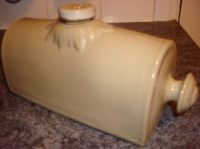-
History of:
- Resources about:
- More:
- Baby walkers
- Bakehouses
- Bed warmers
- Beer, ale mullers
- Besoms, broom-making
- Box, cabinet, and press beds
- Butter crocks, coolers
- Candle snuffers, tallow
- Clothes horses, airers
- Cooking on a peat fire
- Drying grounds
- Enamel cookware
- Fireplaces
- Irons for frills & ruffles
- Knitting sheaths, belts
- Laundry starch
- Log cabin beds
- Lye and chamber-lye
- Mangles
- Marseilles quilts
- Medieval beds
- Rag rugs
- Rushlights, dips & nips
- Straw mattresses
- Sugar cutters - nips & tongs
- Tablecloths
- Tinderboxes
- Washing bats and beetles
- Washing dollies
- List of all articles
Subscribe to RSS feed or get email updates.
Bed warmers puzzle & answers
 A beautiful antique brass warming pan filled with glowing embers warms the sheets
well and so does a modern hot water bottle. But who warmed their bed with a pig?
Who used a monk? And where did people use cherry stones?
A beautiful antique brass warming pan filled with glowing embers warms the sheets
well and so does a modern hot water bottle. But who warmed their bed with a pig?
Who used a monk? And where did people use cherry stones?
The pig was a Scottish stoneware hot water bottle. Even though children could see its nice little snout, the name pig has no animal origins at all. It's a Scottish/northern English word for a round pot. (The snout - see right - is a handle that stays cool. The other knob is the stopper.)
The monk was the French (moine) and Italian (monaco) name for a large wooden frame with a container of glowing embers perched inside it. The frame made a nice big warm cave between the top and bottom sheets. It would heat up gradually without any risk of scorching the sheets and without anyone having to stand there moving a bedwarmer on a handle up and down. In Italy it was also called priest (prete) or nun (monaca).
 The cherry stones were collected by Swiss children, cleaned and sewn into a
bag. When this was warmed in a moderate oven the result was just like today's
microwaveable heat packs. In fact, cherry stone “cushions” (Kirschsteinkissen or Chriesisteichüssi) are now on sale as natural alternatives to other kinds of warmer.
The cherry stones were collected by Swiss children, cleaned and sewn into a
bag. When this was warmed in a moderate oven the result was just like today's
microwaveable heat packs. In fact, cherry stone “cushions” (Kirschsteinkissen or Chriesisteichüssi) are now on sale as natural alternatives to other kinds of warmer.
Different explanations are given for calling the framed bed warmer a monk, but there surely must be a monk-in-the-bed joke in there somewhere. In England these were called bed wagons
The pottery hot water bottle had its own jokes, not only about pigs but also about calves. To follow these, you need to know that a chaff/straw mattress was filled with caff [calf?] in Scotland.
 30 May 2007
30 May 2007
You may like our new sister site Home Things Past where you'll find articles about antiques, vintage kitchen stuff, crafts, and other things to do with home life in the past. There's space for comments and discussion too. Please do take a look and add your thoughts. (Comments don't appear instantly.)
For sources please refer to the books page, and/or the excerpts quoted on the pages of this website, and note that many links lead to museum sites. Feel free to ask if you're looking for a specific reference - feedback is always welcome anyway. Unfortunately, it's not possible to help you with queries about prices or valuation.

